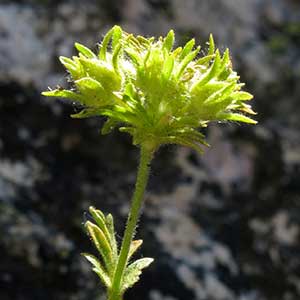Ivesia longibracteata
Ivesia santolinoides
Castle Crags ivesia, longbract mousetail
mouse tail ivesia, Sierra mousetail, silver mousetail, stellariopsis
ascending to erect, 0.3–1.2 dm.
ascending to erect, (1–)1.5–4 dm.
weakly planar to loosely ± cylindric, (0.5–)2–4(–6) cm; sheathing base glandular abaxially, otherwise glabrous;
petiole 0.5–2 cm, hairs 0.2–1 mm;
leaflets 5–6 per side, 2–6 mm, ± short-hirsute, glandular-puberulent, lobes 2–7, oblanceolate to spatulate or obovate, apex not setose.
mousetail-like (individual leaflets scarcely distinguishable), 3–10 cm; sheathing base densely strigose abaxially;
petiole 0.5–1.5 cm;
leaflets 60–80 per side, 0.6–1.5 mm, lobes (0–)3–5, obovate to oval, densely villous.
1–3, not paired.
3–14-flowered, 1–2.5 cm diam.;
glomerules 1.
(10–)30–200-flowered, 3–8(–30) cm diam.
1.5–6 mm.
5–30 mm.
8–10 mm diam.;
epicalyx bractlets linear to narrowly lanceolate or elliptic, 2.5–5 mm, longer than sepals;
hypanthium shallowly cupulate, 0.5–1 × 2–3 mm;
sepals 1.5–2.5 mm, ± acute;
petals pale yellow, linear to narrowly oblanceolate, 1.5–2.5 mm;
stamens 5, filaments 0.7–1.3 mm, anthers yellow, 0.5–0.8 mm;
carpels 6–11, styles 1–1.5 mm.
5–8 mm diam.;
epicalyx bractlets oblong to broadly ovate or orbiculate, 0.2–0.5 mm;
hypanthium 0.5–1.5 × 2–3 mm;
sepals 1–2 mm, apex obtuse to acute;
petals white, broadly obovate to orbiculate, 2–2.5 mm;
stamens 15, filaments 1.2–1.8 mm, anthers purple, broadly obcordate to pouch-shaped, 0.3–0.4 mm;
carpels 1, styles 2–3 mm.
cream to light tan, 1.2–1.5 mm.
mottled grayish brown, 1.7–2 mm.
= 28.
Ivesia longibracteata
Ivesia santolinoides
Of conservation concern.
Ivesia longibracteata is known only from the Castle Crags area of Shasta County. The epithet alludes to a diagnostic characteristic unique in the genus: the epicalyx bractlets are longer than the sepals. The plants grow on vertical rock faces, a habitat more characteristic of sect. Setosae; however, the stems are ascending to erect and do not form hanging clumps, and the pedicels are not curved in fruit.
(Discussion copyrighted by Flora of North America; reprinted with permission.)
Ivesia santolinoides is found on loose granitic substrates in the Sierra Nevada, Transverse Ranges, and San Jacinto Mountains from El Dorado to Riverside counties. The species is easily recognized by its silvery mousetail-like leaves and erect, diffuse inflorescences with small, plumlike flowers.
(Discussion copyrighted by Flora of North America; reprinted with permission.)


